Imagine being a slave in Ethiopia during the 12th and 13th century reign of King Lalibela. Now imagine being handed a chisel, hammer, and an axe, and told to carve a three-story high church out of solid rock. Inconceivable, certainly. But when you consider that the King actually completed construction of the 11 magnificent rock-hewn churches of Lalibela in a span of just 23 years, the feat is practically incomprehensible.
Perhaps he had help beyond the corporeal plane. It is said that Lalibela performed miracles throughout his life. According to legend, when he was born his body was covered with a swarm of bees. His name is a combination of two words, “lal” and “ybella,” which translates to “honey eaters.” Today the city that is home to the rock-hewn churches proudly bears his name, and the surrounding countryside produces the country’s finest honey.
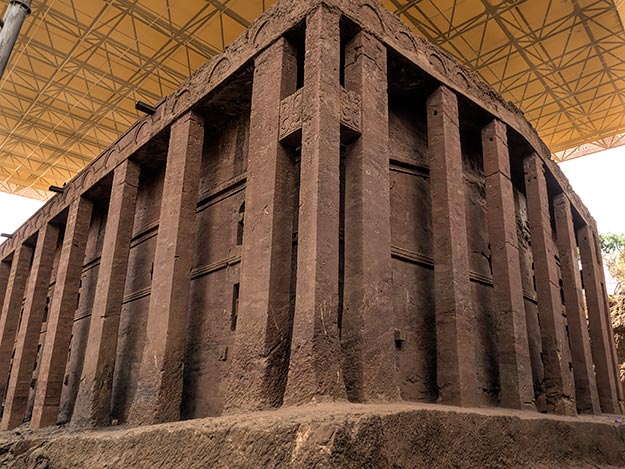
Ethiopia adopted Christianity in the first half of the fourth century, making it one of the earliest countries in the world to do so. King Lalibela was a devout Christian and still today, nearly all residents of the town named in his honor are Eastern Orthodox Christians. Myths swirl around this remarkable monarch. Ethiopians believe he was transported to Jerusalem numerous times by the archangels Gabriel and Michael. It was during one of these visits that God directed him to sculpt the rock-hewn churches of Lalibela out of the surrounding volcanic stone. This New Jerusalem, as it was known, allowed pilgrims to continue honoring their God after Muslim conquests halted Christian pilgrimages to the Holy Land.

Today these churches stand as one of the world’s best examples of rock-cut architecture. Each of the 11 churches were carved from solid rock in a single piece. Some are “monolithic” – attached to the rock only at the base, while others are attached to the base as well as one or more side walls, making them “semi-monolithic.” I began with the Northern Group of churches. After a brief visit to the site’s small museum, my guide led me to Bete Medhane Alem (Saviour of the World). Considered to be the largest rock-hewn church in the world, it can hold up to 500 people. Inside, the dense stone walls oozed solemnity. I found it difficult to speak louder than a whisper as I wandered between pillars, examining antique carpets, giant handmade drums, and ancient tapestries covering the walls from floor to ceiling.
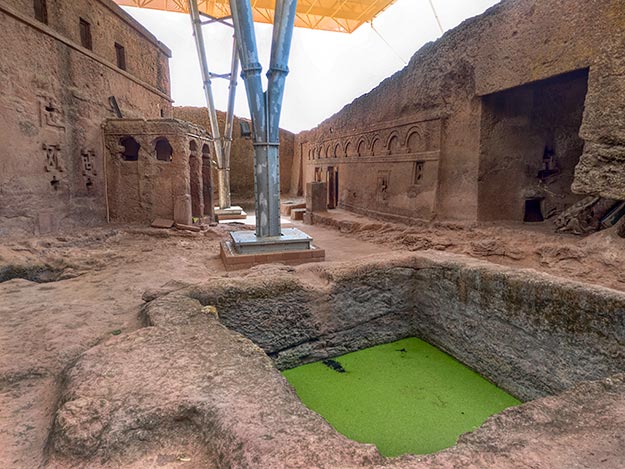
We continued to a second courtyard shared by Bete Maryam (House of Mary), Bete Meskel (House of the Cross), and Bete Sillase. Bete Maryam was the first church built and is reputed to contain frescoes painted by Lalibela himself.
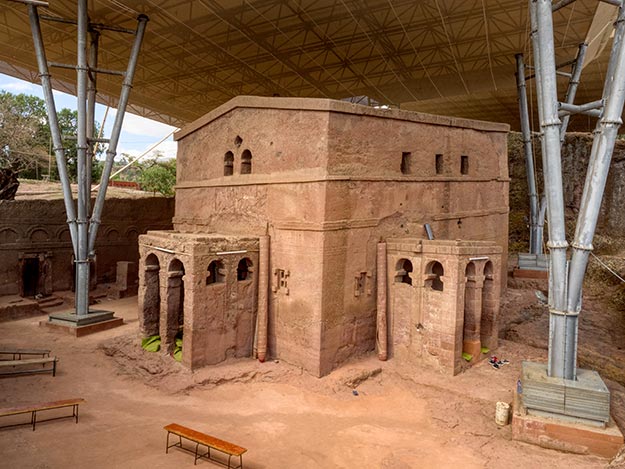
Bete Maryam in the northeastern group of rock-hewn churches of Lalibela
The most interesting feature of Bete Maryam are its windows (see the photo below). The top row of three windows represents the Father, Son, and Holy Ghost. Just below, the window with a cross represents Jesus, while the unusual cutout beneath the cross represents the womb of Mary. The bottom row is symbolic of the crucifixion. Jesus is in the center, flanked by two windows that represent the two thieves who were crucified on either side of him. The thief on the right asked for and was granted forgiveness by Jesus, thus he ascended into heaven (note the carved arrow pointing upward above the window). The window on the left represents the thief who did not repent of his sins, thus he was not forgiven and descended into hell (note the carved arrow pointing down).
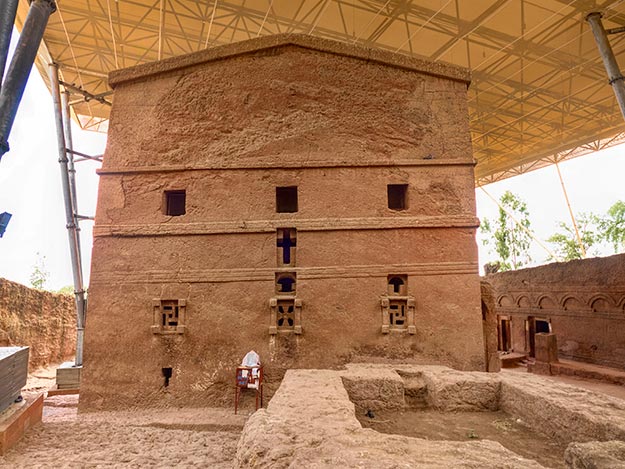
Also of note within the Northern Group was Bete Denagel (House of Virgins). A remarkable, ancient painting on cowhide of St. George slaying the Dragon is on display inside this small, windowless sanctuary.
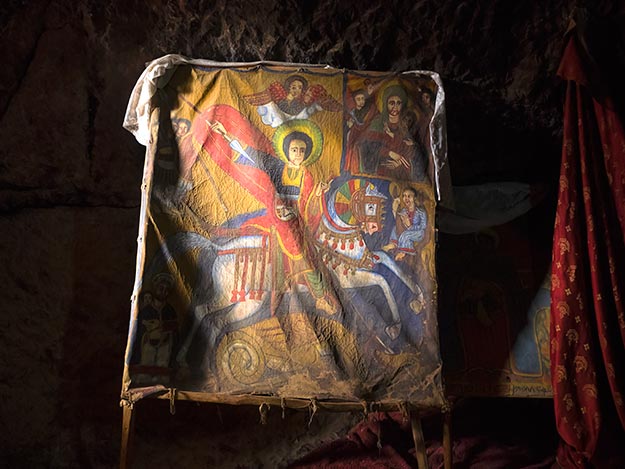
The following day we explored the Southeastern Group, beginning with the Church of the Archangel Gabriel and Raphael. Because of its location next to a kitchen where the holy host was prepared for all four churches in the group, some believe this structure was originally used as a royal palace.
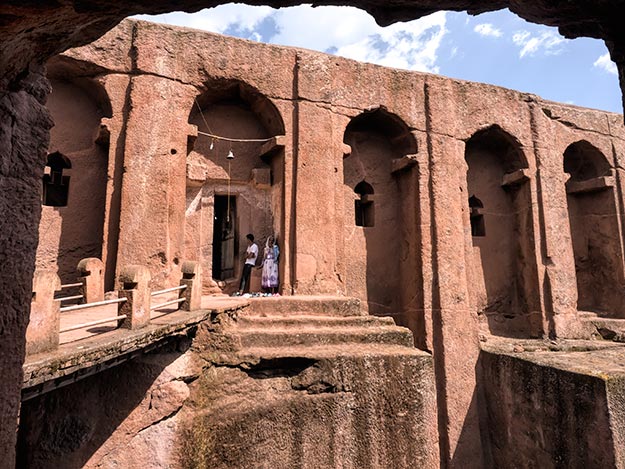
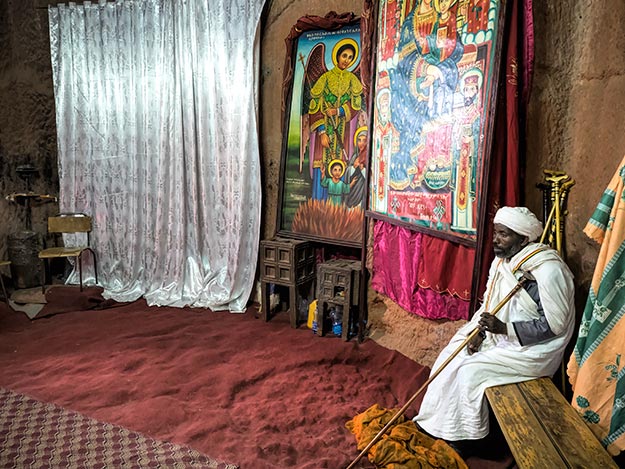
The most impressive of the Eastern Group was Bete Amanuel (House of Emmanuel), the only monolithic church in this grouping. Bete Markorios, the second largest of all, would be impressive if not for water damage that has collapsed its roof.
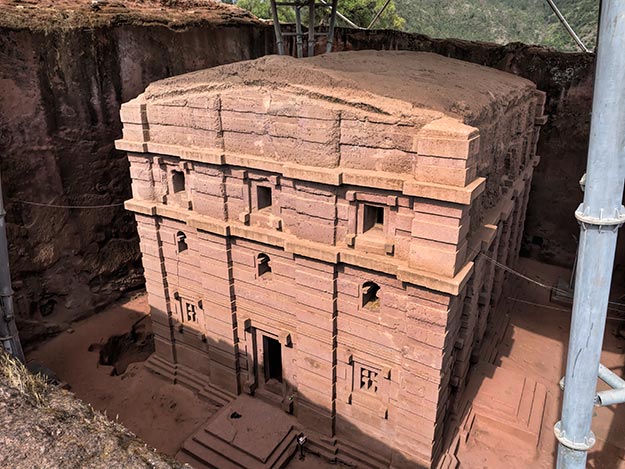
But without doubt, the highlight of the rock-hewn churches of Lalibela was Bete Giyorgis (the Church of Saint George). Thought to be the most finely executed and best preserved rock-cut church in the world, it is the highlight of any trip to Ethiopia. Carved from the surrounding volcanic tuff in the shape of a cross, it has three stories and stands nearly 40-feet high. Lalibela employed everything he had learned from constructing the 10 previous churches. First, workers excavated a free-standing block of stone out of the bedrock, then removed all the waste material from the pit. Stone masons carefully chiseled the church from the solid block, shaping both the exterior and interior of the building into the form of a cruciform cross.
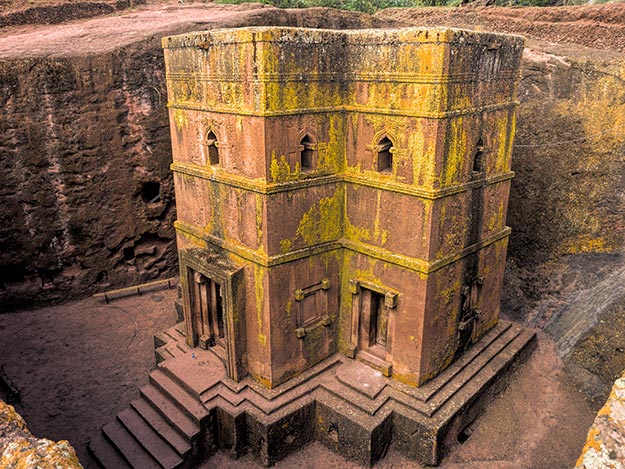
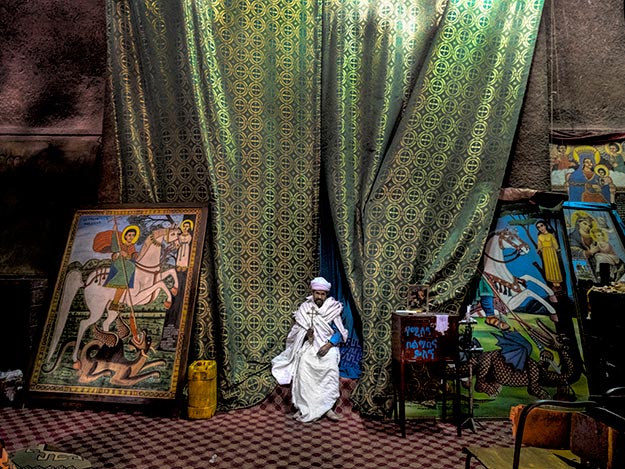
It was an astonishing achievement, and one that seemed even more impossible when I stood atop an adjacent hill for an overview. Just before sunset, the clouds parted and the rich afternoon sun streamed down, turning Bete Giyorgis into a burnished golden cross that seemed to be dangling from the hand of God.
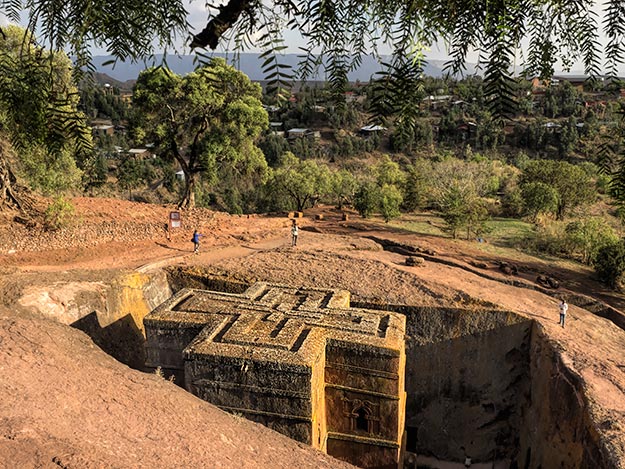
Nine-hundred years after they were weaned from the surrounding rock, the rock-hewn churches of Lalibela are still a major pilgrimage site. Not only do the faithful travel to Lalibela from all over the world to pray for blessings and healings, each of the churches continue to host worship services that are faithfully attended by the locals every Sunday. It’s no wonder that the rock-hewn churches of Lalibela have been awarded UNESCO World Heritage Site status and are often referred to as the “Eighth Wonder of the World.”

Consistent with the johnnie-come-lately fake histories that are constantly written by the historically racist, or so-called “white” governments of America, England, France, Italy and the like, when they write to demean the history of brown-skinned people, your statement that “slaves” built the Lalibela temples is false and of foreign origin.
The government of Ethiopia has never practiced racist policies. The claim that the government of Ethiopia practiced racism as done by so-called whites makes no sense. Any claims that the government of Ethiopia ever endorsed slavery for racist reasons is false and originates only from enemies of Ethiopia.
New organization funded in part by so-called whites, Anglos, Saxons and their elk may be teaching and hiring certain kids to teach this new mythology but it is a false and makes no sense. Everyone in Lalibela is the same color and has same origin. This new found mythology makes no more sense than the foreign mythology that the Lalibela temples were originally built around time of the 13th century. Though modified around time of the 13th century, the temples were originally erected thousands of years ago.
Again, the government has Ethiopia has never practiced slavery
There is definitely a heaven!!! So many awesome things on earth. How can anyone deny? Love reality tv. About time. Show us the world. To all who can’t afford to travel.
if you watch carefully, you will notice the structure, the same as the indian temples mentioned before, clearly looks af done by moulding, or using a clay-like substance that hardened afterwards, all the shapes in the rock tells you so, the same as any ceramic sculpture done by hand or aided by basic tools. there are many kinds of ceramics that hardens over time, maybe in this case, it was a natural ceramic, that was naturaly available at the time, that petrified over time, moreover, you can see that even the dirt around it, or mud, is petrified also, meaning this structure was done like at least 4000 years ago or about it, when the muds left by the big flood were still freesh, even there is a chance they were still bland enough after some thousands of years, but no way to tell. even to say more, there is a chance this was built on top of an uncompletelly unearthed struckture previous to the flood. which even could be the whole case. official story will unlikely tell you this, cause they have to promote the fake theory or evolution, and age-periods, which many scholars disagree with, but are silenced due going against the official promoted story.
Beautiful pictures with this story. Looks like a fascinating adventure.
You begin by saying that “slaves” built these churches. Just out of curiosity, is that what you were told by people who live there, or if you imagine that to be the case?
No disrespect for you or your travels, just curiosity. Thank you, and many more happy trails to you!
Hi Susan: This is what I was told by the government trained and licensed guide at the site. There are differing opinions, but almost everything I have read on the subject agrees that slave labor would have been used at the site. The argument seems more centered around how many people were actually enslaved in those days. I appreciate your question and curiosity!
So glad I stumbled upon this detailed article on Lalibela. Lalibela was a king so devoted to his beliefs who once ruled Ethiopia, such a genius ruler to say the least but this amazing art would never be possible without God’s will because its said that king Lalibela died went to heaven and God himself showed him the very blueprint of The Magnificent Rock-Hewn Churches of Lalibela and he came back to earth and with the help of Angels he was able to leave us this astonishing piece of art am so proud to be from this historic land!!!!
Hello Missale: Thanks so much for your comment. I thought Ethiopia was one of the most fascinating countries I’ve ever visited, and I’ve been to more than 100 countries!
I gave my thank to Barbara weibel, form Ethiopia
You are very welcome Beteslase. I’m pleased you enjoyed my article.
I hadn’t heard of these rock-hewn churches, Barbara. Sounds like such an exotic and intriguing trip! Such a wonderful experience!
They were considered one of the eight wonders of the ancient world, Crystal, and it’s not hard to see why. Hope you get to see them one day.
What a destination. Ethiopia has been on my wishlist for ages, and your post makes me want to book a flight post-haste. Great images, Barbara!
Thanks so much Anita. I have to say, Ethiopia was quite remarkable, and not only for the rock-hewn churches. It’s not the easiest destination for travelers, but well worth the difficulties.
Thanks for sharing.
You’re welcome Adinor. Thanks for your comment.
As a person who grew up visiting Indonesia’s centuries-old Hindu-Buddhist temples, I have grown a proclivity for ancient structures. I remember six or seven years ago when I first stumbled upon an article on Lalibela, I was immediately fascinated by its story. Thanks for bringing this incredible story up again, and this post reminds me how Ethiopia should be the first country to set foot in Africa should the opportunity to go to that part of the world arise for me.
Hi Bama. I promise you won’t be disappointed. Ethiopia is simply amazing – and I don’t use that word lightly. Watch for more articles about Ethiopia coming up on the blog.
So difficult for me to conceive the idea of hewn rock. Or carving something out of rock. Add the size and scale of these places, and my confusion jumps 400 levels….amazing Barbara!
Ryan
It was truly amazing Ryan. I also couldn’t conceive of doing such a thing, and I was standing there looking down at them!